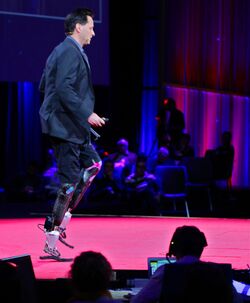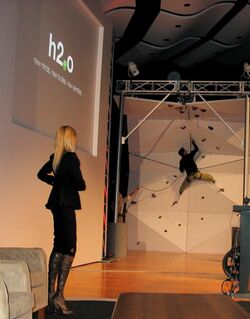Hugh Herr
Topic: Biography
 From HandWiki - Reading time: 7 min
From HandWiki - Reading time: 7 min
Hugh Herr | |
|---|---|
 Herr in 2013 | |
| Born | Hugh Miller Herr October 25, 1964 Lancaster, Pennsylvania, U.S. |
| Nationality | United States |
| Alma mater | Millersville University Massachusetts Institute of Technology Harvard University |
| Scientific career | |
| Fields | Biophysics Mechanical engineering Physics |
| Institutions | Massachusetts Institute of Technology |
| Website | media |
Hugh Herr (born October 25, 1964) is an American rock climber, engineer, and biophysicist.
Early life
The youngest of five siblings of a Mennonite family from Lancaster, Pennsylvania, Hugh Herr was a prodigy rock climber: by age eight, he had scaled the face of the 11,627-foot (3,544 m) Mount Temple in the Canadian Rockies, and by 17 he was acknowledged to be one of the best climbers in the United States .[1]
In January 1982, after having ascended a difficult technical ice route in Huntington Ravine on Mount Washington in New Hampshire, Herr and a fellow climber Jeff Batzer were caught in a blizzard and became disoriented, ultimately descending into the Great Gulf where they passed three nights in −20 °F (−29 °C) degree temperatures. By the time they were rescued, the climbers had suffered severe frostbite. Both of Herr's legs had to be amputated below the knees; his companion lost his lower left leg, the toes on his right foot, and the fingers on his right hand. During the rescue attempt, volunteer Albert Dow was killed by an avalanche.[1]
Following months of surgeries and rehabilitation, Herr was doing what doctors told him was unthinkable: climbing again. Using specialized prostheses that he designed, he created prosthetic feet with high toe stiffness that made it possible to stand on small rock edges the width of a coin, and titanium-spiked feet that assisted him in ascending steep ice walls. He used these prostheses to alter his height to avoid awkward body positions and to grab hand and foot holds previously out of reach. His height could range from five to eight feet. As a result of using the prostheses, Herr climbed at a more advanced level than he had before the accident, making him the first person with a major amputation to perform in a sport on par with elite-level, able-bodied persons.[2][3]
Personal life
Hugh Herr has two daughters, Alexandra and Sage. Under the direction and guidance of their mother, author Patricia Ellis Herr, both girls are accomplished hikers and trekkers. Alex's earliest hiking achievements are described in Patricia's memoir, Up: A Mother and Daughter's Peakbagging Adventure (Broadway Books, April 2012).
Education
After his climbing career, Herr began to focus on academics, previously an area of little interest to him. He earned an undergraduate degree in physics at his local college, Millersville University, and a master's degree in mechanical engineering at MIT, followed by a PhD in biophysics from Harvard University.
Career
While a postdoctoral fellow at MIT in biomedical devices, he began working on advanced leg prostheses and orthoses, devices that emulate the functionality of the human leg.[1]
Currently, Herr is a professor at the MIT Media Lab, where he directs the Biomechatronics research group and co-directs the MIT Center for Extreme Bionics.[4][5] Within the Center, he focuses on developing wearable robotic systems that serve to augment human physical capability. Most of what he designs is not for him, but for others to whose difficulties he can relate.
Herr has published over 120 peer-reviewed papers[6] in the field of rehabilitation science and is the holder (or co-holder) of more than 100 patents[7] related to assistive devices, including those for a computer-controlled artificial knee,[8] commercially available as the Rheo Knee[9] an active ankle-foot orthosis, and the world's first powered ankle-foot prosthesis.[10]
These devices are advancing an emerging field of engineering science that applies principles of biomechanics and neural control to guide the designs of human rehabilitation and augmentative devices.[11] The goal is to rehabilitate individuals that have undergone limb amputation or have suffered a pathology, and also to augment human physical capability for those with normal intact physiologies.
The computer-controlled knee, which is outfitted with a microprocessor that continually senses the joint's position and the loads applied to the limb, was named to the list of Top Ten Inventions in the health category by TIME magazine in 2004.[12] The robotic ankle-foot prosthesis, which mimics the action of a biological leg and, for the first time, provides transtibial amputees with a natural gait, was named to the same TIME top-ten list in 2007.[13]

In 2007, Herr was presented with the 13th Annual Heinz Award for Technology, the Economy and Employment.[14] He is also the recipient of the Popular Mechanics Breakthrough Leadership Award (2005).[15]
Herr was a member of a team of seven experts in biomechanics and physiology from six universities that conducted research on the mechanics of Oscar Pistorius' running blades. The South African bilateral amputee track athlete was banned by the International Association of Athletics Federations (IAAF) from running in able-bodied events, as previous research had shown the blades gave him a competitive advantage.[16] A portion of these results were presented to the Court of Arbitration for Sport (CAS) in Lausanne, Switzerland in May 2008, by Herr and colleague Rodger Kram which resulted in reversing the ban. This allowed Pistorius to become the first disabled sprint runner to qualify against able-bodied athletes for an Olympic event.[17] The full findings of the team's experiments were published in the June 18, 2009 issue of the Journal of Applied Physiology.[18]
Herr's story has been told by Alison Osius in the book Second Ascent: The Story of Hugh Herr; a Discovery Channel feature story; and in a 2002 National Geographic movie, Ascent: The Story of Hugh Herr.
Herr was featured on a March 25, 2012 episode of CNN's The Next List.[19]
Notable grants and awards
- Sports Hall of Fame (1989)
- United States College Academic Team (1990)
- Young American Award (1990)
- Science magazine Next Wave: Best of 2003
- TIME magazine Top Ten Inventions 2004[12]
- With the Providence VA Center for Restorative and Regenerative Medicine and Brown University, a $7.2 million grant from the US Department of Veterans Affairs to create "biohybrid" limbs to restore natural function to amputees. (2004)
- Popular Mechanics Breakthrough Leadership Award (2005)[15]
- 13th Heinz Award in Technology, the Economy and Employment (2007)[14]
- TIME magazine Top Ten Inventions 2007[13]
- Action Maverick Award (2008)[20]
- Spirit of Da Vinci Award (2008)[21]
- R&D Magazine’s 2014 Innovator of the Year[22]
- Smithsonian magazine's American Ingenuity Award (2014) in the Technology Category
- Princess of Asturias Award for Technical & Scientific Research (2016)[23]
Notable rock climbs
- 1983 Vandals, Gunks, FA with Lynn Hill and Russ Clune, first 5.13 on the East Coast.[24]
- 1984 Stage Fright (5.12c X), Cathedral Ledge, North Conway, NH. First Ascent.[25]
- 1986 Ride of the Valkyries (5.12a), Careno Crag, Leavenworth, WA – First Ascent.[26]
- 1986 City Park (5.13c), Index Town Walls, WA – 2nd ascent.[27]
Biography
- Osius, Alison (1991). Second Ascent: The Story of Hugh Herr. Mechanicsburg, PA: Stackpole Books. ISBN 978-0-8117-1794-6.
References
- ↑ 1.0 1.1 1.2 Adelson, Eric (March 2009). "Best Foot Forward". Boston Magazine. http://www.bostonmagazine.com/2009/02/best-foot-forward-february/. Retrieved December 31, 2016.
- ↑ Osius, Alison (1991). Second Ascent: The Story of Hugh Herr. Mechanicsburg, PA: Stackpole Books. ISBN 978-0-8117-1794-6.
- ↑ "Ascent - The Story of Hugh Herr". YouTube. https://www.youtube.com/watch?v=rkw_OJ2nto4. Retrieved December 31, 2016.
- ↑ Todd Balf (6 September 2017). "The Biomechatronic Man". Outside Magazine. https://www.outsideonline.com/2238401/biomechatronic-man. Retrieved 10 October 2017.
- ↑ "How MIT Media Lab is advancing human physicality, cognition, and emotional experience through bionic augmentation" (in en). TechRepublic. https://www.techrepublic.com/article/how-mit-media-lab-is-advancing-human-physicality-cognition-and-emotional-experience-through-bionic/.
- ↑ "Google Scholar". https://scholar.google.com/scholar?hl=en&as_sdt=0,22&q=+author:%22h+herr%22+hugh&btnG=.
- ↑ "ininventor:"Hugh M. Herr" - Google Search" (in en). https://www.google.com/search?tbm=pts&tbm=pts&q=ininventor:%22Hugh+M.+Herr%22&biw=1608&bih=897&dpr=0.9.
- ↑ Carswell, Lindsay (February 12, 2005). "New Robotic Knee". Science Central. Archived from the original on October 29, 2010. https://web.archive.org/web/20101029053337/http://www.sciencentral.com/articles/view.php3?article_id=218392697. Retrieved December 31, 2016.
- ↑ Zamiska, Nicholas (July 6, 2004). "Bionic Knee 'Learns' How to Walk". The Wall Street Journal. https://www.wsj.com/ad/article/philips/SB108907039283655627.html. Retrieved December 31, 2016.
- ↑ Singer, Emily; Graham-Rowe, Duncan (May 11, 2007). "Biomedicine The World's First Powered Ankle". MIT Technology Review. https://www.technologyreview.com/s/407894/the-worlds-first-powered-ankle/. Retrieved December 31, 2016.
- ↑ Helgessen, Sally (October 3, 2016). "Hugh Herr Wants to Build a More Perfect Human". Strategy+Business. http://www.strategy-business.com/article/Hugh-Herr-Wants-to-Build-a-More-Perfect-Human.
- ↑ 12.0 12.1 "Smooth Operator - The Best Inventions Of 2004". Time. September 19, 2011. http://content.time.com/time/specials/packages/article/0,28804,1940424_1940477,00.html. Retrieved December 31, 2016.
- ↑ 13.0 13.1 "Joint Venture - The Best Inventions Of 2007". Time. November 1, 2007. http://content.time.com/time/specials/2007/article/0,28804,1677329_1678169,00.html. Retrieved May 4, 2010.
- ↑ 14.0 14.1 "Hugh Herr". The Heinz Awards. http://www.heinzawards.net/recipients/hugh-herr. Retrieved December 31, 2016.
- ↑ 15.0 15.1 Ward, Logan (September 28, 2005). "2005 Popular Mechanics Breakthrough Awards". Popular Mechanics. http://www.popularmechanics.com/technology/a298/1762911/. Retrieved December 31, 2016.
- ↑ "Study Revives Olympic Prospects for Amputee Sprinter". MIT Media Lab. May 15, 2008. https://www.media.mit.edu/news/releases/2008/05/study-revives-olympic-prospects-amputee-sprinter. Retrieved December 31, 2016.
- ↑ Sauser, Brittany (May 21, 2008). "Amputee Gets a Shot at the Olympics". MIT Technology Review. https://www.technologyreview.com/s/410167/amputee-gets-a-shot-at-the-olympics/. Retrieved December 31, 2016.
- ↑ G. Weyand, Peter; W. Bundle, Peter; P. McGowan, Craig; Grabowski, Alena; Brown, Beth; Kram, Rodger; Herr, Hugh (June 18, 2009). "The fastest runner on artificial legs: different limbs, similar function?". Journal of Applied Physiology. http://jap.physiology.org/content/jap/early/2009/06/18/japplphysiol.00174.2009.full.pdf. Retrieved December 31, 2016.
- ↑ "Coming up on 'The Next List': Hugh Herr, Bionic man". CNN.com. March 20, 2012. http://edition.cnn.com/2012/03/20/tech/this-week-on-the-next-list-hugh-herr-bionic-man/index.html. Retrieved December 31, 2016.
- ↑ "Action Maverick". STREB. http://streb.org/action-maverick/. Retrieved December 31, 2016.
- ↑ "Spirit Of Da Vinci Award Goes To MIT Bio-Mechantron Professor - Amputee Designing The Next Generation Of Prostheses". Medical News Today. September 12, 2008. http://www.medicalnewstoday.com/releases/121158.php. Retrieved December 31, 2016.
- ↑ Hock, Lindsay (August 12, 2014). "R&D Magazine Announces Scientist and Innovator of the Year Award Winners". R&D Magazine. http://www.rdmag.com/news/2014/08/r-d-magazine-announces-scientist-and-innovator-year-award-winners. Retrieved December 31, 2016.
- ↑ "Princess of Asturias Award for Technical & Scientific Research 2016 - Hugh Herr". The Princess of Asturias Foundation. 2016. http://www.fpa.es/en/princess-of-asturias-awards/laureates/2016-hugh-herr.html. Retrieved December 31, 2016.
- ↑ Clune, Russ (Spring 2009). "Vandals, Shawangunks". Patagonia – Field Report. Patagonia, Inc. Archived from the original on June 30, 2009. https://web.archive.org/web/20090630114838/http://www.patagonia.com/web/us/patagonia.go?slc=en_US&sct=US&assetid=40837. Retrieved Dec 24, 2009.
- ↑ Green, Stewart (2001). Rock Climbing New England. Guilford CT: Falcon Books. p. 100. ISBN 978-1-56044-811-2.
- ↑ Smoot, Jeff (2000). "A Walk in the Park". ClimbingWashington.com. Archived from the original on April 8, 2001. https://web.archive.org/web/20010408053721/http://climbingwashington.com/features/walkinthepark3.htm. Retrieved December 27, 2009.
- ↑ Martin, Jason (April 14, 2005). "Only strong climbers need apply themselves to the daunting granite of Index". Seattle PI (Seattle PI.com). http://www.seattlepi.com/getaways/219792_townwall14.html. Retrieved Dec 24, 2009.
External links
- MIT Media Lab: Hugh Herr, Associate Professor of Media Arts and Science
- MIT Media Lab: Biomechatronics
- BiOM Board of Directors: Dr. Hugh Herr – Founder
- {{TED speaker}} template missing ID and not present in Wikidata.
- YouTube Video "The World We Dream – Hugh Herr Zeitgeist" 2012
- Boston Magazine "Best Foot Forward," 2/09
- Esquire "Hugh Herr's New Parts," 11/30/06
- Wired Italy "Hugh Herr: L'impronta dell'evoluzione," 5/13/09
- National Geographic Channel "Ascent: The Story of Hugh Herr"
- MIT News "Herr wins $250,000 Heinz Award" 9/12/07
- The Heinz Awards, Hugh Herr profile
 KSF
KSF
